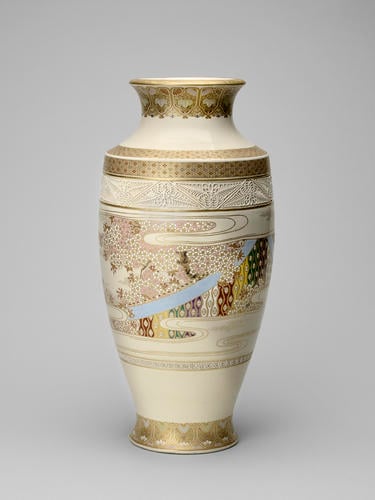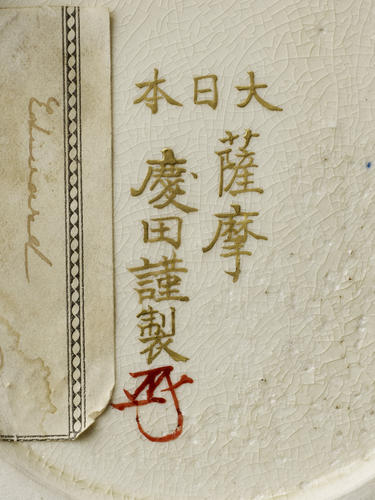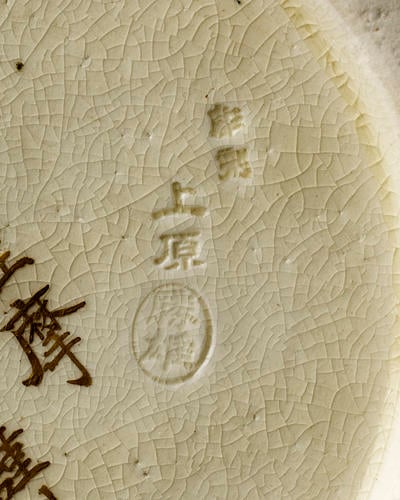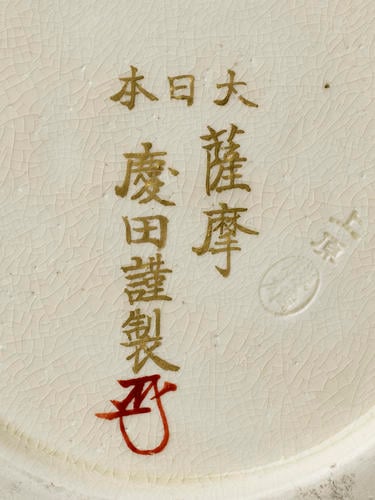-
1 of 253523 objects
Pair of vases 1900-22
Glazed pottery with decoration moulded and painted in enamel colours and gold | 46.3 x 20.5 x 20.5 cm (whole object) | RCIN 152

Japan
Master: Pair of vases Item: Autumn 1900-22

Japan
Master: Pair of vases Item: Spring 1900-22

Japan
Master: Pair of vases Item: Autumn 1900-22

Japan
Master: Pair of vases Item: Spring 1900-22

Japan
Master: Pair of vases Item: Spring 1900-22





-
These elegant vases represent spring and autumn respectively. The first (RCIN 152.1) is decorated with cherry blossom, signifying spring, and the other (RCIN 152.2) with chrysanthemums, indicating autumn. Both scenes appear in swirling clouds which dissolve into the cream glaze of the vase, suggesting the ephemerality of each season. On RCIN 152.1, cherry blossom and Goshiki-maku (‘five coloured curtain’) indicate spring, while RCIN 152.2 features chrysanthemums and an Ajiro wickerwork partitioning screen, symbolising the autumn season. The vases have high shoulders near the neck, a shape known as katatsuki, which gives prominence to the main decoration on the body. The design is the work of Keida Masatarō who by the early twentieth century was considered one of the foremost potters in Kagoshima; in 1904, he won a Gold Medal at the Louisiana Purchase Exhibition.
Porcelain in this style was displayed to resounding success by the Satsuma domain at the Paris Exposition Universelle of 1867. European and American consumers were dazzled by the combination of a white body with crackle glaze and delicate gold and polychrome enamel decoration. Further interest at the 1873 Vienna World Exhibition and the 1876 Philadelphia Centennial Exposition generated considerable demand for export pieces, which were soon produced across southern Kyūshū and elsewhere in Japan. Many displayed minute figures and imaginary landscapes evoking an ‘exotic’ Japan which would appeal to western taste. Here, by contrast, established Japanese motifs are rendered confidently and sparingly. Uehara Kumaji’s delicate, moulded decoration round the neck is of particularly fine quality.
The chrysanthemum and paulownia flowers in the borders are associated with the Imperial Household, indicating the official character of the vases. They were a gift to Edward, Prince of Wales from the Kagoshima Prefectural Office during his visit to that prefecture on 9 May 1922. Few Satsuma-style wares are found in the Royal Collection today, although they evidently appealed to royal taste: Queen Mary bid unsuccessfully for a large lot of Satsuma ware at the C.T. Hawkins sale in 1927.
On each base is written in gold: D.
Top (horizontal)
大日本
Dai Nippon
Great Japan
Right (vertical)
薩摩
Satsuma
Left (vertical)
慶田謹製
Keida kinsei
Made with care and attention by Keida
There is a Kakisan maker’s seal in red, which appears to be that of Keida Masataro (1852–1924).Text adapted from Chinese and Japanese Works of Art in the Collection of Her Majesty The Queen: Volume II and Japan: Courts and Culture (2020)
Provenance
Presented to King Edward VIII when Prince of Wales by the Kagoshima Prefectural Office, 9 May 1922
-
Creator(s)
(nationality)Acquirer(s)
-
Medium and techniques
Glazed pottery with decoration moulded and painted in enamel colours and gold
Measurements
46.3 x 20.5 x 20.5 cm (whole object)
Category
Object type(s)
Other number(s)